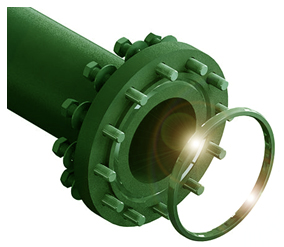Ring Joint Types

Ring joints are used in the chemical and petroleum industries to provide a high-pressure seal to pipes during drilling and other applications. Iron and steel are some of the base materials of the joint, and it’s usually finished with a coating of cadmium or zinc, but the materials can vary according to use. Because ring joints are usually used in conjunction with flanges, choosing the correct joint for the flange gives you maximum sealing.
Oval Ring Joints
Oval ring joints are useful for operations that involve high pressure, high heat and highly corrosive substances. The design is also ideal for its ability to “coin” to the connecting pipe, which means there is no leakage. The oval joint must be made of a softer metal than the flange it is fitted to, so soft iron and carbon steel are frequently-used materials. The petroleum, petro-chemical and steam industries are the principal users of the oval ring joint.
Octagonal Ring Joints
The octagonal ring joint is more efficient at sealing than the oval ring joint, and can handle pressure of up to 10,000 PSI. They are ideal for newer-styled flat-bottomed grooved connections, and sizing for octagonal joints is standardized, so finding the right fit shouldn’t be a problem. Octagonal ring joints made with graphite can also be used with flanges that have slight imperfections. During heating, the graphite fills is in uneven areas and creates a seal.
Blind Ring Joints
Blind ring joints are thinner than most ring joints and are especially useful for splayed, or wide, flanges. They are usually placed at the end of pipework to provide a high pressure seal, but differ from regular ring joints because they include a metallic center, with bolt holes included for attachment. Although blind ring joints come in standardized sizes and materials, they can be made as per specification.
Transition Ring Joints
Transition ring joints are ideal when dealing with flanges that have two different diameters for the ring groove. Metal joints are available in oval or octagonal shapes, depending on the cross section of the piping, and rubber joints can also can be purchased for used in the water and pipe industry. Transition joints are also called combination joints, and usually have to be specially ordered.










